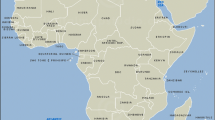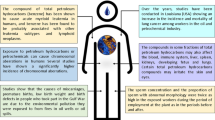Abstract
In Tabasco the petroleum industry pollutes soil recurrently by oil spills. We analysed Pb, V, Ni and Cr concentrations in water samples, and total metal contents and metal fractions in soil samples of contaminated and non-contaminated soils and in sediments. Besides, we determined Eh, pH, DOC and major ions in water and Eh, pH, Corg in soils and sediments. Sediments contained considerably larger heavy metal (HM) concentrations than soils. Local background concentrations of V, Ni and Cr in soils are larger than global means and oil spillages have not added these metals in quantities that exceed the natural variation. Spillage of formation water increases Pb concentrations in soils, particularly in mobile fractions. The contribution of the oil industry to HM loads is diluted by large fluvial water and sediment discharges and difficult to assess by comparison of total metal contents. Therefore, easily mobile metal fractions are much better indicators.



Similar content being viewed by others
References
Allison, J. D., Brown, D. S., & Novo-Gradac, K. J. (1991). MINTEQA2/PRODEFA2, A geochemical assessment model for environmental systems. Version 3.0. Washington, D.C.: United States Environmental Protection Agency, Office of Research and Development.
Brookins, D. G. (1988). Eh-pH Diagrams for Geochemistry. Springer-Verlag, Berlin, Heidelberg.
Buchman, M. F. (1999). NOAA screening quick reference tables. NOAA HAZMAT Report 99-1, Seattle WA, Coastal Protection and Restoration Division, National Oceanic and Atmospheric Administration.
Cantillo, A. Y., & O’Connor, T. P. (1992). Trace elements contaminants in sediments from the NOAA National Status and trends programme compared to data from throughout the world. Chemistry and Ecology, 7, 1–50. doi:10.1080/02757549208055431.
Cram, S., Siebe, C., Ortíz, R., & Herre, A. (2004). Mobility and persistence of petroleum hydrocarbons in tropical peat soils in south eastern Mexico. Soil and Sediment Contamination, 13, 41–360. doi:10.1080/10588330490500392.
Fiedler, H. J., & Rössler, H. J. (1988). Spurenelemente in der Umwelt. Ferdinand Enke Verlag, Stuttgart.
Gold-Bouchot, G., Sima-Alvarez, R., Zapata-Perez, O., & Gumez-Ricalde, G. (1995). Histopathological effects of petroleum hydrocarbons and heavy metals on the American Oyster (Crassostrea virginica) from Tabasco, Mexico. Marine Pollution Bulletin, 31, 439–445. doi:10.1016/0025-326X(95)00171-I.
Long, E. R., MacDonald, D. D., Smith, S. L., & Calder, F. D. (1995). Incidence of adverse biological effects ranges of chemical concentrations in marine and estuarine sediments. Environmental Management, 19, 81–97. doi:10.1007/BF02472006.
Macías-Zamora, J. V., Villaescusa-Celayas, J. A., Muñoz-Barbosa, A., & Gold-Bouchot, G. (1999). Trace metals in sediment cores from the Campeche shelf, Gulf of México. Environmental Pollution, 104, 69–77. doi:10.1016/S0269-7491(98)00153-5.
Manriquez, L., Moreno, A., Tenorio, R. E., & Herrera, D. (2000). Guide to world crudes. Four Mexican crude assays updated. Oil & Gas Journal, 15, 54–57.
Marín-Mezquita, L., Baeza, L., Zapata-Pérez, O., & Gold-Bouchot, G. (1997). Trace metals in the American oyster, Crassostrea virginica, and sediments from the coastal lagoons Mecoacán, Carmen and Machona, Tabasco, Mexico. Chemosphere, 34, 2437–2450. doi:10.1016/S0045-6535(97)00046-5.
Ortíz-Pérez, M. A., Siebe, C., & Cram, S. (2005). Diferenciación ecogeográfica de Tabasco. In J. Bueno, F. Álverz & S. Santiago (Eds.), Biodiversidad del Estado de Tabasco, Instituto de Biología, Universidad Nacional Autónoma de México, CONABIO, México (pp. 305-322).
PEMEX (1999). Informe 1999: Seguridad, Salud y Medio Ambiente. Mexico: Dirección Corporativa de Seguridad Industrial y Protección Ambiental.
PEMEX. (2004). Anuario estadistico. Censo de instalaciones y ductos. Retrieved November 22, 2005, from http/www.pep.pemex.com
SARH (1981). Boletín 14, Cuenca del Río Coatzacoalcos, Región hidrológica 29. México, D.F: Secretaría de Agricultura y Recursos Hidráulicos.
SEMARNAT. (2005). Compendio de estadísticas ambientales. Retrieved September 21, 2005, from htpp/www.semarnat.gob
Siebe, C., Cram, S., Herre, A., & Fernández-Buces, N. (2005). Distribución de metales pesados en los suelos de la llanura alluvial baja del Activo Cinco Presidentes, Tabasco. In A. V. Botello, J. Rendón von Osten, G. Gold-Bouchot & C. Agraz-Hernández (Eds.), Golfo de México-Contaminación e Impacto Ambiental. Diagnóstico y Tendencias (pp. 385-403). Universidad Autónoma de Campeche- UNAM.
Sparks, D. L. (2005). Toxic metals in the environment: The role of surfaces. Elements, 1, 193–197. doi:10.2113/gselements.1.4.193.
Trujillo, A., Lagunez, E. L., & Bocanegra, A. (1995). Dinámica de metales pesados en suelos y ríos en Comalcalco, Tabasco. Memorias del XXVI Congreso Nacional de la Ciencia del Suelo, Cd. Victoria, Tamaulipas, México, p. 42.
van den Berg, G. A., Loch, G., van der Heijdt, L. M., & Zwolfsman, J. J. G. (2000). Geochemical behaviour of trace metals in freshwater sediments. In B. Markert & K. Friese (Eds.), Trace Elements (pp. 517-533). Elsevier Science.
Vázquez, G. F., Elias, D. M., Aguayo, J. E. C., & Alejandro, B. (1996). Trace metal species in aquatic samples of the Tabasco lagoons, Mexico. Environment International, 22, 377–382. doi:10.1016/0160-4120(96)00024-4.
Vázquez, G. F., & Sharma, V. K. (2004). Major and trace elements in sediments of the Campeche Sound, southeast Gulf of Mexico. Marine Pollution Bulletin, 48, 87–90. doi:10.1016/S0025-326X(03)00328-X.
Vázquez, F. G., Sharma, V. K., & Perez-Cruz, L. (2002). Concentrations of elements and metals in sediments of the southeastern Gulf of Mexico. Environmental Geology, 42, 41–46. doi:10.1007/s00254-001-0522-7.
Villanueva, F.S., & Páez-Osuna, F. (1996). Niveles de Metales en el Golfo de México: Agua, Sedimentos y Organismos. In A. V. Botello, J. L. Rojas-Galaviz, J. Benítez & D. Zárate-Lomelí (Eds.), Golfo de México, Contaminación e Impacto Amiental: Diagnóstico y Tendencias. Universidad Autónoma de Campeche, EPOMEX Serie Científica 5, pp. 309-347.
Villanueva, S., & Botello, A. V. (1998). Metal pollution in coastal areas of Mexico. Reviews of Environmental Contamination and Toxicology, 157, 53–94.
West, R. C., Psuty, N. P., & Thom, B. G. (1969). The Tabasco Lowlands of Southeastern Mexico. Louisiana State University Press. Coastal Studies Series Number 27, 193 p.
WRB. (2006). World Reference Base for Soil Resources. Retrieved February 20, 2007, from http://www.fao.org/ag/Agl/agll/wrb/doc/wrb2006final.pdf.
Zeien, H., & Brümmer, G. W. (1989). Chemische Extraktion zur Bestimmung der Schwermetallverbindungsformen in Böden. Mitteilungen Deutsche Bodenkundliche Gesellschaft, 59, 505–510.
Acknowledgements
We thank M.Sc. Kumiko Shimada for the general soil and sediment analyses, Daniel Pinales Bravo for his support in field work, and Dr. Barbara Martiny for revising the English manuscript. The Eiselen-foundation, Ulm, supported the travel expenses of Brigitte Roth to Mexico.
Author information
Authors and Affiliations
Corresponding authors
Additional information
Capsule: Large local background concentrations and their variability obscure the assessment of environmental metal loads by the petroleum industry.
Rights and permissions
About this article
Cite this article
Fiedler, S., Siebe, C., Herre, A. et al. Contribution of Oil Industry Activities to Environmental Loads of Heavy Metals in the Tabasco Lowlands, Mexico. Water Air Soil Pollut 197, 35–47 (2009). https://doi.org/10.1007/s11270-008-9789-6
Received:
Accepted:
Published:
Issue Date:
DOI: https://doi.org/10.1007/s11270-008-9789-6




